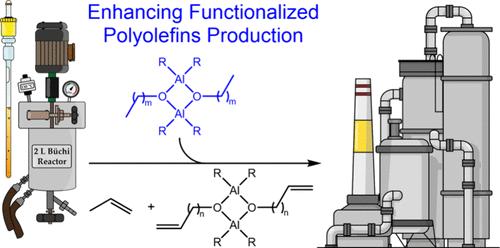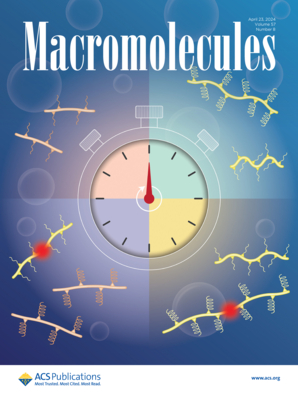Functionalized Polyolefins Produced by Post-Metallocenes; High Added Value Materials, but Can They Be Produced Efficiently?
IF 5.2
1区 化学
Q1 POLYMER SCIENCE
引用次数: 0
Abstract
Randomly functionalized polyolefins produced by catalysis have received increasing attention owing to their well-defined molecular structures, uniform distribution, and variety in types of functionalities. Herein, we investigate the scalability of the production of hydroxyl-functionalized propylene copolymers via a high temperature solution polymerization process using aluminum trialkyls as passivating agents. Initially, we evaluated the impact of (i) the type of passivating agent (triethylaluminum versus triisobutylaluminum) and (ii) the distance between the hydroxyl and olefin functionality within the functionalized comonomer on the catalytic activity and the functional comonomer incorporation efficiency. Both the functional comonomer’s chain length and the type of trialkylaluminum passivating agent have a profound effect on the incorporation efficiency. Subsequently, deeper insight into the origin of the catalyst poisoning by trialkylaluminum-passivated hydroxyl-functionalized comonomers reveals that catalyst deactivation solely happens after incorporation of the functional comonomer and not by coordination of the oxygen of the functional comonomers present in the reaction system. During recycling of dialkylaluminum alkenolates by means of distillation, the occurrence of carbo- and/or hydroalumination side reactions were noticed, triggered by the presence of dialkylaluminum hydrides formed by thermolysis of excess aluminum trialkyls. Exchanging aluminum trialkyls by dialkylaluminum alkoxides as scavengers solved this problem. Modeling studies revealed the impact of the higher nuclearity of trialkylaluminum-passivated hydroxyl-functionalized comonomers on their incorporation efficiency. Addition of a saturated alcohol significantly improved the incorporation efficiency of the functional comonomer, thus bringing the scalability (i.e., enhance the productivity and cost-efficiency) of the copolymerization process a step closer.

后茂金属生产的功能化聚烯烃;高附加值材料,但能否高效生产?
通过催化生产的随机官能化聚烯烃因其分子结构明确、分布均匀、官能类型多样而受到越来越多的关注。在此,我们研究了使用三烷基铝作为钝化剂,通过高温溶液聚合工艺生产羟基官能化丙烯共聚物的可扩展性。首先,我们评估了(i)钝化剂类型(三乙基铝与三异丁基铝)和(ii)官能化共聚单体中羟基与烯烃官能团之间的距离对催化活性和官能化共聚单体加入效率的影响。官能团单体的链长和三烷基铝钝化剂的类型对掺入效率都有很大影响。随后,对三烷基铝钝化剂羟基官能化单体导致催化剂中毒的原因进行深入研究后发现,催化剂失活仅仅发生在官能化单体掺入之后,而不是反应体系中存在的官能化单体的氧配位。在通过蒸馏法回收二烷基铝烯醇酸盐的过程中,发现由于过量三烷基铝热分解形成的二烷基铝氢化物的存在,引发了碳化和/或氢化副反应。用二烷基铝烷氧基交换三烷基铝作为清除剂解决了这一问题。模型研究揭示了三烷基铝钝化羟基官能化共聚单体较高的核度对其掺入效率的影响。添加饱和醇可显著提高功能共聚单体的掺入效率,从而使共聚工艺的可扩展性(即提高生产率和成本效益)更进一步。
本文章由计算机程序翻译,如有差异,请以英文原文为准。
求助全文
约1分钟内获得全文
求助全文
来源期刊

Macromolecules
工程技术-高分子科学
CiteScore
9.30
自引率
16.40%
发文量
942
审稿时长
2 months
期刊介绍:
Macromolecules publishes original, fundamental, and impactful research on all aspects of polymer science. Topics of interest include synthesis (e.g., controlled polymerizations, polymerization catalysis, post polymerization modification, new monomer structures and polymer architectures, and polymerization mechanisms/kinetics analysis); phase behavior, thermodynamics, dynamic, and ordering/disordering phenomena (e.g., self-assembly, gelation, crystallization, solution/melt/solid-state characteristics); structure and properties (e.g., mechanical and rheological properties, surface/interfacial characteristics, electronic and transport properties); new state of the art characterization (e.g., spectroscopy, scattering, microscopy, rheology), simulation (e.g., Monte Carlo, molecular dynamics, multi-scale/coarse-grained modeling), and theoretical methods. Renewable/sustainable polymers, polymer networks, responsive polymers, electro-, magneto- and opto-active macromolecules, inorganic polymers, charge-transporting polymers (ion-containing, semiconducting, and conducting), nanostructured polymers, and polymer composites are also of interest. Typical papers published in Macromolecules showcase important and innovative concepts, experimental methods/observations, and theoretical/computational approaches that demonstrate a fundamental advance in the understanding of polymers.
 求助内容:
求助内容: 应助结果提醒方式:
应助结果提醒方式:


